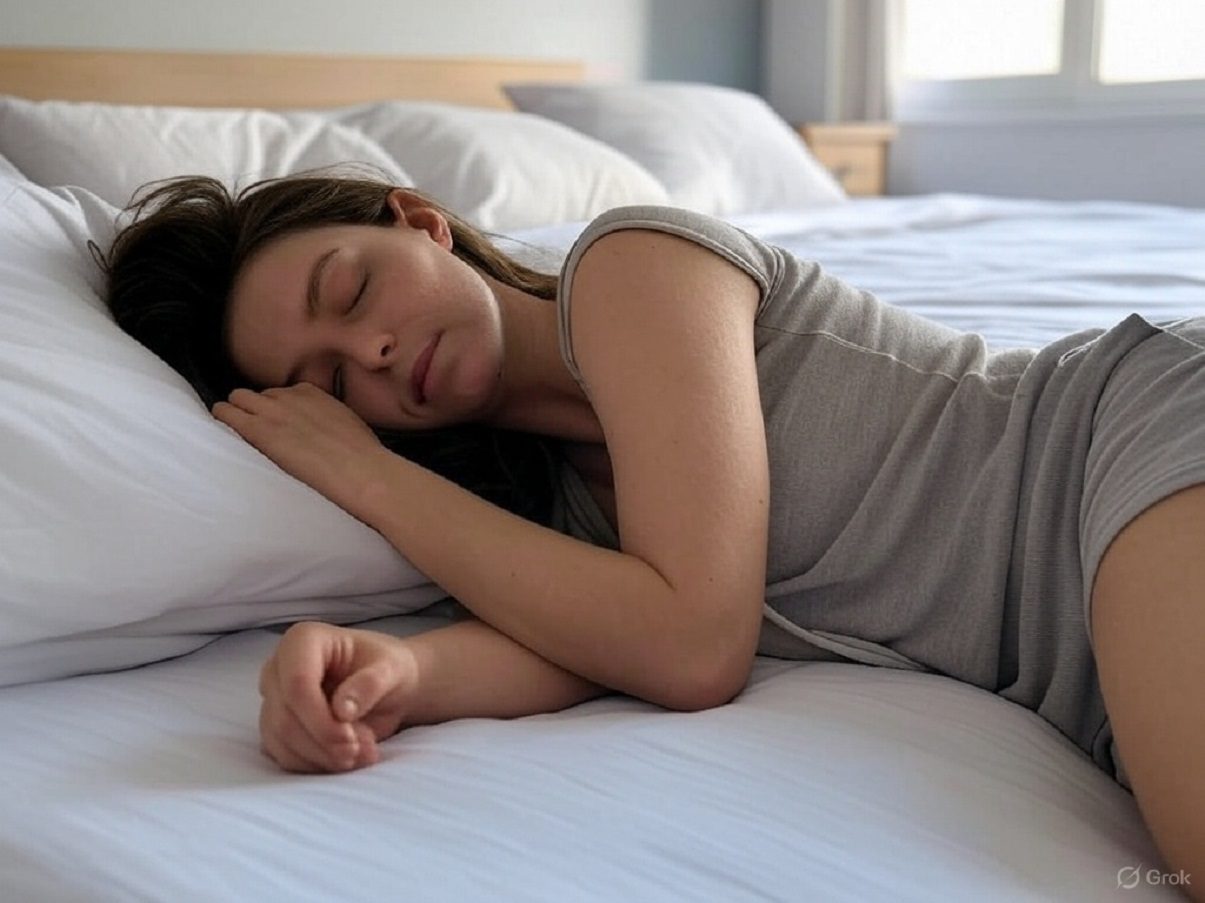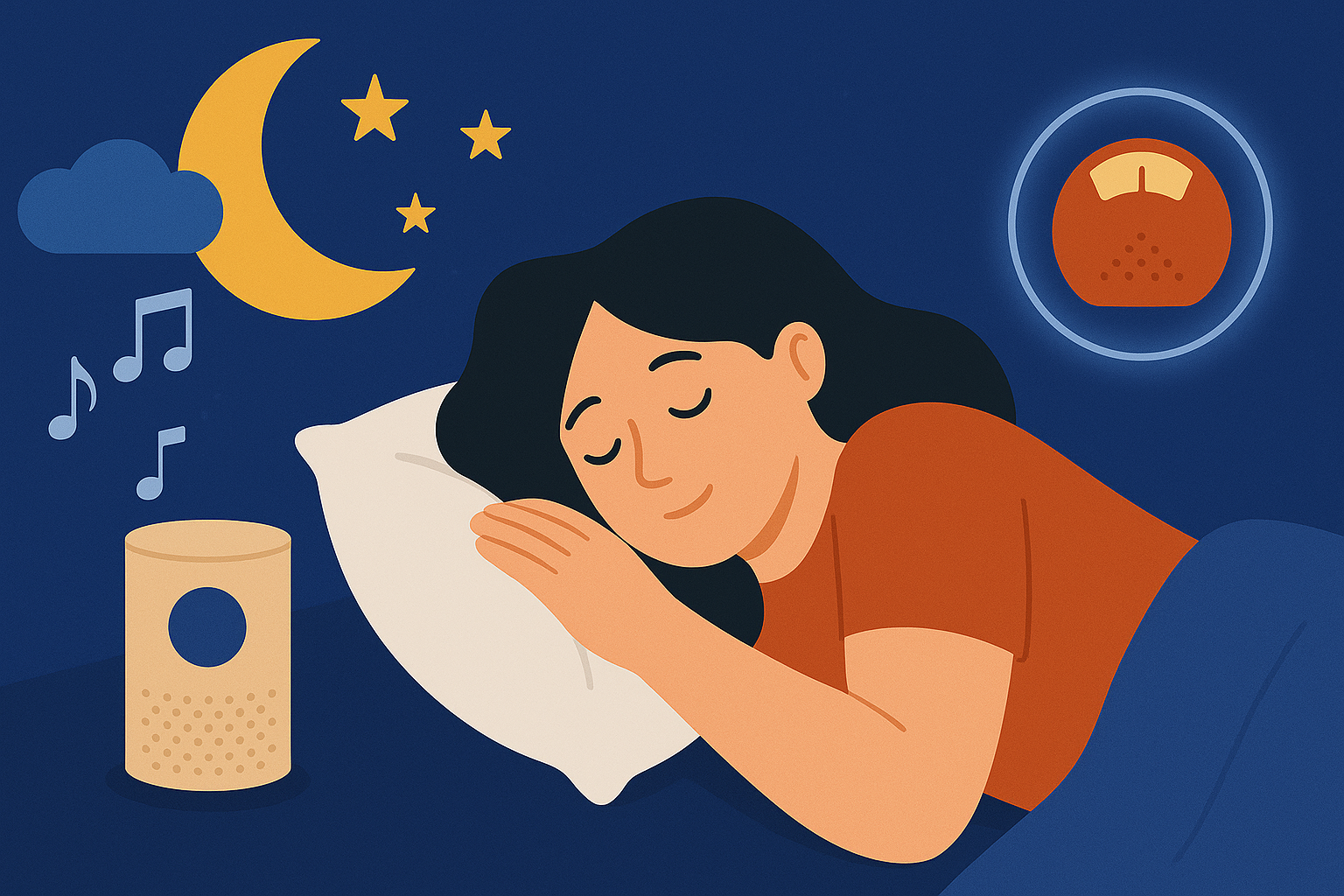These soothing sleep sounds promote deeper sleep cycles—especially slow-wave sleep, where your body burns fat and repairs itself.
1. Brown Noise
Low-frequency and soft. Less harsh than white noise. Helps with racing thoughts.
Try: “Deep Brown Noise – 8 Hours of Low Roaring Sound”
2. Rain on a Tin Roof
Rhythmic, nostalgic, and cozy. Triggers parasympathetic relaxation.
Try: “Rain on Metal Roof – Heavy Rain for Sleeping”
3. Ocean Waves
Mimics your breathing pattern. Reduces anxiety and cortisol.
Try: “Gentle Ocean Waves with Seagulls in the Distance”
4. Forest Ambience
Birds, rustling leaves, distant wind. Ideal for mindful sleep.
Try: “Morning Forest Soundscape – No Music, Just Nature”
5. Crackling Fireplace
Warmth without the heat. Triggers feelings of safety and rest.
Try: “Cozy Fireplace Sounds – Winter Cabin Sleep Ambience”
6. Tibetan Singing Bowls
Ancient healing tones. Good for meditative, deep sleep.
Try: “528Hz Healing Sleep with Tibetan Bowls”
7. Delta Brainwave Music (0.5–4 Hz)
Scientifically designed to induce deep NREM sleep.
Try: “Delta Waves Sleep Music – 3 Hours for Deep Healing Sleep”

8. Wind Chimes in the Breeze
Soft, random tones. Great for light sleepers who wake easily.
Try: “Backyard Wind Chimes – Evening Breeze Sounds”
9. Underwater Bubbles
Unusual but effective. Mimics womb-like serenity.
Try: “Deep Sea Bubble Sounds – Hypnotic Sleep Sound”
10. White Noise Fan Sound
Simple, classic. Masks household noise. Best for urban environments.
Try: “Box Fan Sound – White Noise for Sleep and Focus”
Final Thought: Sleep Is Your Slim-Down Superpower
Sleep isn’t a luxury. It’s biology’s fat-burning ritual.
You can count every calorie, jog every mile—but if your sleep is off, your weight may not budge.
So tonight, give yourself permission to shut off early. Put on a sound that soothes you. Let your body do its best work—while you sleep.
Best Frequency for Sleep (Sound Frequency for Deep Sleep)
When it comes to sound frequencies that aid in deep, restorative sleep, science points to low-frequency sounds—especially those that match or influence brainwave activity. Here’s a breakdown of the best sleep-promoting frequencies:

Frequently Asked Questions (FAQ) on Sleep
1. How many hours of sleep do adults really need?
Most healthy adults need 7–9 hours of quality sleep each night. Individual needs vary slightly, but regularly getting fewer than 6 hours is linked to higher risks of obesity, diabetes, and cardiovascular disease.
2. Why do I still feel tired after 8 hours of sleep?
Quantity isn’t everything—sleep quality matters, too. Fragmented sleep, untreated sleep disorders (like sleep apnea), late-night caffeine/alcohol, blue‑light exposure, or a misaligned circadian rhythm can all leave you groggy despite adequate hours.
3. What’s the difference between REM and deep (slow‑wave) sleep?
- REM (Rapid Eye Movement): Dream‑heavy stage, important for memory consolidation, learning, and mood regulation.
- Slow‑wave / Deep Sleep (Stage N3): Physically restorative phase when tissue repair, growth hormone release, and fat‑burning processes peak. Healthy adults cycle through both stages several times a night.
4. Does napping help or hurt nighttime sleep?
Short “power naps” (15–25 minutes) can boost alertness without harming nighttime sleep. Long or late‑afternoon naps (>60 minutes) may interfere with your ability to fall asleep at night.
5. How does poor sleep contribute to weight gain?
Sleep deprivation raises ghrelin (hunger hormone) and lowers leptin (satiety hormone). You crave calorie‑dense foods, exercise less, and experience insulin resistance—creating a perfect storm for weight gain.
6. Is it bad to look at screens before bed?
Yes. Blue light from phones, tablets, and TVs suppresses melatonin, the hormone that signals your body it’s time to sleep. Aim for a “digital sunset”—switch off bright screens at least 60 minutes before bedtime.
7. Do sleep sounds or white noise really work?
For many people, consistent ambient sounds (white, brown noise, rain, etc.) mask disruptive noises and help the brain relax, promoting deeper sleep. The key is volume: keep it below 50 dB (quiet conversation level).
8. What foods or drinks help promote better sleep?
Light snacks containing tryptophan (e.g., yogurt, almonds, turkey) or complex carbs (whole‑grain toast) can support melatonin production. Avoid caffeine after 2 p.m. and limit alcohol, which disrupts REM sleep later in the night.
9. How can I reset a “broken” sleep schedule?
- Wake up at the same time every day—even weekends.
- Get morning sunlight to anchor your circadian clock.
- Limit naps to <30 minutes before 2 p.m.
- Gradually shift bedtime earlier by 15 minutes every two nights.
Consistency is key; allow 1–2 weeks for full adjustment.
10. When should I see a doctor about sleep problems?
Consult a healthcare provider if you:
Experience excessive daytime sleepiness, uncontrollable naps, or restless legs.
Proper diagnosis can prevent long‑term health complications.
Snore loudly or gasp for air during sleep (possible sleep apnea)
Struggle to fall or stay asleep ≥3 nights per week for >3 months (chronic insomnia)


